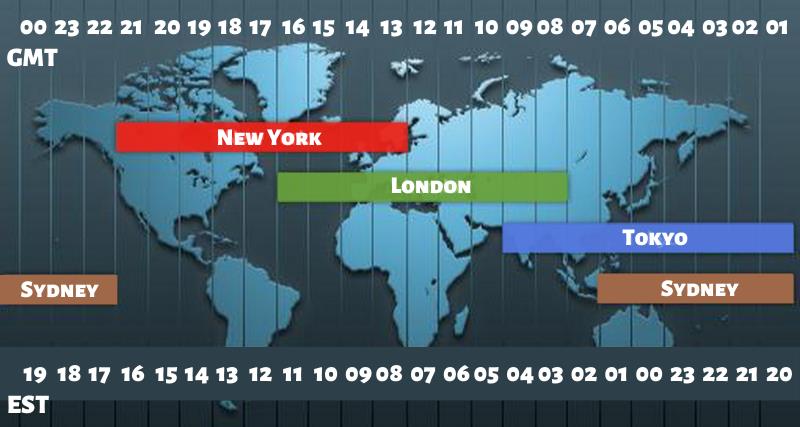Forex Market Hours
Data is continually updated by our staff and systems.
Last updated: 10 Feb 2021
We earn commissions from some affiliate partners at no extra cost to users (partners are listed on our ‘About Us’ page in the ‘Partners’ section). Despite these affiliations, our content remains unbiased and independent. We generate revenue through banner advertising and affiliate partnerships, which do not influence our impartial reviews or content integrity. Our editorial and marketing teams operate independently, ensuring the accuracy and objectivity of our financial insights.
Read more about us ⇾
Live Forex Sessions by Time Zone
Main Forex Market Hours
The main Forex market hours are when the two most liquid trading sessions, London and New York overlap each other. This spike in extra liquidity and market activity happens during the daily sessions, from Monday to Friday, in the period between 1:00 p.m. GMT, when New York opens to 4:00 p.m. GMT, when London closes.
Table of Contents
The Forex market is an around the clock market, open 24 hours, 5.5 days a week. The four main financial centres open for business at 8:00 a.m. local time, trading currencies, and as some financial hubs close, others open to begin a new trading session.
Each trading day begins in Sydney, Australia, at 10:00 p.m. GMT, and progresses to the next major financial centre, Tokyo, then London, and finally New York, with each centre opening according to the business hours in that city’s time zone.
Each daily trading session, comprising the four main financial centres trading sessions, “ends” at 10:00 p.m. GMT. But the Forex market hours does not actually end at that time during the weekdays. The Forex market only closes on Friday at 10:00 p.m. GMT for the weekend, re-opening at 10:00 p.m. GMT on Sunday.
This means that retail traders can open or close any position at any time from Sunday, when Sydney begins operations, to Friday, when New York stops trading.
The Foreign Exchange Market is a decentralized market, that is, it does not have one centre where transactions and prices must go through. Instead, it is an Over-the-Counter Market where parties trade directly between themselves, and where there’s no central exchange. That being said, there are 10 principal Forex Transaction Centres in the world, by turnover:
| Country | Average Daily Turnover Expressed in USD Billions | As a Percentage of World Daily Turnover |
|---|---|---|
| United Kingdom | $1,359 | 34.1% |
| United States | $664 | 16.6% |
| Switzerland | $242 | 6.0% |
| Japan | $238 | 5.9% |
| Singapore | $231 | 5.8% |
| Hong Kong SAR | $175 | 4.3% |
| Australia | $170 | 4.2% |
| France | $120 | 3.0% |
| Germany | $99 | 2.5% |
| Denmark | $86 | 2.2% |
| Others | $614 | 15.4% |
| Total | $3,998 | 100% |
The 10 largest trading centres in the world account for a daily turnover average of USD 3.384 billion or 84.6% of the world total. The United Kingdom (or the London trading session, to be specific) is the largest Forex trading financial centre in the world, accounting for 34.1% of the daily world currency turnover.
The London session, due to its turnover, is by far the most important in the currency exchange market and therefore it’s a time session to pay attention to. The United States (or NYC, to be specific) finishes second place at 16.6% so it also counts as a serious session to trade. Tokyo and Sydney (Australia) also get considered as time sessions because of their location and good trading volume.
Forex Market Open Time

As mentioned at the beginning of the article, the Forex market is a decentralized 24-hours market with trading sessions in different parts of the world. There isn’t an opening and closing time for this market, but rather a combination of different sessions overlapping each other.
As a rule of thumb, the global Forex market is open for trade from 10:00 p.m. GMT on Sunday until 10:00 p.m. GMT on Friday.
During the week days, there is always, at least, one market open, and there are a couple of windows where two sessions overlap between one region's market closing and another opening.
The international scope of foreign exchange trading means that there are always traders globally who are trading and injecting volumes for a particular currency pair.
Each Forex market trading day starts in Australasia, with the first session in Wellington, New Zealand, also considered a major financial center. The Forex market is open in New Zealand, on Monday morning 8:00 a.m. local time, while most traders are still enjoying the Sunday in most of the world.
Being a decentralized market, until Friday there isn’t a formally closing time during the week. Still, as sessions overlap each other, there’s also a brief lacuna in trading activity between 8:00 p.m. and 10:00 p.m. GMT when most American traders have finished for the day and most Kiwi and Aussie traders are starting to get ready for work.
Other than the weekends, the only two public holidays when the market is officially closed are Christmas Day (December 25th) and New Year's Day (January 1st).
Below are the tables of the opening and closing times, ordered by first session to last one, for each financial centre's session, in their local time and respective time zone:
| Forex Financial Centres | Currency | Local Trading Hours | Time Zone | |
|---|---|---|---|---|
| Asia | Wellington, New Zealand | NZD | 8:00 a.m. - 5:00 p.m. | UTC+12 (+13 |
| Sydney, Australia | AUD | 8:00 a.m. - 5:00 p.m. | UTC+10 (+11) | |
| Tokyo, Japan | JPY | 8:00 a.m. - 5:00 p.m. | UTC+9 | |
| Hong Kong, China | HKD | 9:00 a.m. - 5:00 p.m. | UTC+8 | |
| Shanghai, China | CNY | 9:00 a.m. - 5:00 p.m. | UTC+8 | |
| Singapore, Singapore | SGD | 9:00 a.m. - 5:00 p.m. | UTC+8 | |
| Europe | Frankfurt, Germany | EUR | 8:00 a.m. - 4:00 p.m. | UTC+1 (+2) |
| Zurich, Switzerland | CHF | 9:00 a.m. - 5:30 p.m. | UTC+1 (+2) | |
| Paris, France | EUR | 9:00 a.m. - 5:30 p.m. | UTC+1 (+2) | |
| London, UK | GBP | 8:00 a.m. - 4:00 p.m. | UTC+1 | |
| America | New York, United States | USD | 8:00 a.m. - 5:00 p.m. | UTC-5 (-4) |
| Toronto, Canada | CAD | 8:00 a.m. - 5:00 p.m. | UTC-5 (-4) | |
| Chicago, United States | USD | 8:00 a.m. - 4:00 p.m. | UTC-6 (-5) | |
Below is a detailed table of the opening and closing of the major financial centres in multiple time zone formats:
| Time Zone Market Activity | Sydney AEST | Tokyo JST | Hong Kong HKT | Frankfurt Zurich CET | London BST = GMT +1 | GMT | New York EDT | Chicago CDT | Vancouver PDT |
|---|---|---|---|---|---|---|---|---|---|
| NZ stock exchange open | 7:00 | 6:00 | 5:00 | Prev Day 23:00 | 22:00 | 21:00 | 17:00 | 16:00 | 14:00 |
| Australian Start | 9:00 | 8:00 | 7:00 | 1:00 | 0:00 | 23:00 | 19:00 | 18:00 | 16:00 |
| Japan Fundamentals | 9:50 | 8:50 | 7:50 | 1:50 | 0:50 | Prev Day 23:50 | 19:50 | 18:50 | 16:50 |
| Asian Open | 10:00 | 9:00 | 8:00 | 2:00 | 1:00 | 0:00 | 20:00 | 19:00 | 17:00 |
| Asian Dying out | 13:00 | 12:00 | 11:00 | 5:00 | 4:00 | 3:00 | Prev Day 23:00 | 22:00 | 20:00 |
| European Open | 16:00 | 15:00 | 14:00 | 8:00 | 7:00 | 6:00 | 2:00 | 1:00 | Prev Day 23:00 |
| Eurozone Fundamentals | 16:45 | 15:45 | 14:45 | 8:45 | 7:45 | 6:45 | 2:45 | 1:45 | 23:45 |
| London Open | 17:00 | 16:00 | 15:00 | 9:00 | 8:00 | 7:00 | 3:00 | 1:00 | 0:00 |
| UK Economics Figures | 18:30 | 17:30 | 16:30 | 10:30 | 9:30 | 8:30 | 4:30 | 3:30 | 1:30 |
| New York Open | 22:00 | 21:00 | 20:00 | 14:00 | 13:00 | 12:00 | 8:00 | 7:00 | 5:00 |
| USA Ecnomic Figures | 22:30 | 21:30 | 20:20 | 14:30 | 13:30 | 12:30 | 8:30 | 7:30 | 5:30 |
| USA Stock Exchange Open | 23:30 | 22:30 | 21:30 | 15:30 | 14:30 | 13:30 | 9:30 | 8:30 | 6:30 |
| European Close | Next Day 2:00 | Next Day 1:00 | Next Day 0:00 | 18:00 | 17:00 | 16:00 | 12:00 | 11:00 | 9:00 |
| American Dying out | 6:00 | 5:00 | 4:00 | 22:00 | 21:00 | 20:00 | 16:00 | 15:00 | 13:00 |
If you don’t know your time zone, you can consult your computer clock or check out the local time and date in every time zone on the following website: worldtimeserver.com.
In order to use the above table, locate your time zone on one of the columns and follow it down, referencing the different regional sessions and hours via the first column.
For instance, if you live in EST, you would see that New York Trading starts at 8:00 a.m. and ends at 5:00 p.m. (9 hours), there is a 2-hour lull in trading volume before it picks up again for the Tokyo Trading from 7:00 p.m. to 4:00 a.m. (9 hours), and London session overlaps the two sessions, beginning at 3:00 a.m. and ending at noon (9 hours).
Forex Session Times
The global Forex market can be split up into four trading sessions, taking the city names from the principal financial hubs: Sydney, Tokyo, London, and New York.
In terms of trading volumes, the Forex market has three major trading sessions and, globally, traders often focus on one of these three periods, rather than trying to trade the market 24-hours per day.
These sessions consist of the Asian, European, and North American sessions. Let’s look in more detail the characteristics and opening times of each one of:
Tokyo Session Forex
Considered to run from 00:00 to 9:00 a.m. GMT, this is the period that sees the real first activity after the weekend and after the day “end” of 10:00 p.m. GMT. Activity from this part of the world is represented by a few major economies; Japan, China, Australia, New Zealand and Russia, among others.
Unsurprisingly, all Yen paired currencies, the USD/JPY and other crosses such as EUR/JPY, GBP/JPY, EUR/JPY, AUD/JPY and CHF/JPY, are the most active during this time. Nevertheless, most pairs during this time do not move as much as during the next two sessions, as the major market participants from Europe and the United States have not as yet entered into the game.
Consequently, the Asian session is seen as the most muted time, and this can be an advantage: it can be the time to take a rest from trading, because there might not be as many trading opportunities anyway, and it can represent a time to employ scalping and counter-trend systems on currency pairs that tend to move sideways during this time.
Just make sure to end your scalping and counter-trend activity just before the end of the session (8:00 a.m. GMT), when the market has a big jump in volatility because of its overlap with the European open.
Interestingly enough, if you are trading a pair that is a cross made of currencies that are most actively traded during Asian and European hours (like the EUR/JPY and the GBP/JPY); there will be a greater response to the Asian/European session overlap as opposed to the overlap that occurs during the European / US session concurrence.
London Session Forex
The European session runs from 7:00 a.m. GMT to 4:00 p.m. GMT and this session takes over from the Asian trading to accelerate trading activity. Activity from this part of the world is represented largely by the London session and also influenced by a number of other European major financial markets such as Frankfurt, Zurich and Paris.
Ultimately, because the London Forex session processes the largest currency exchange volume, the greatest volatility is when the UK traders are active. Frankfurt, with the Deutsche Bank as the biggest individual FX processor, is another important financial city, and because it is only in an 1-hour time zone different from London, its morning volatility overlaps with that of London.
As logic would suggest, the currencies that are the most active during the European Forex session are related to their demographic tie with their country of origin. During this period, the Euro, the British pound and the Swiss franc see higher volatility on average when the European session is active.
Since these currencies and their pairings with each other and the US dollar represent the bulk of the trading on the majors and minors, it behoves a trader to keep this session on his radar and watch it for price action opportunities.
It is interesting to note that the European session overlaps with other two sessions. The first overlap occurrs on its opening, overlapping with the closing of the Tokyo session, and the second overlap occurrs in the last 3 hours of its trading day, overlapping with the first 3 hours of the US session. These two overlaps are extremely important for noticing increased price volatility and action.
New York Session Forex
Running from 1:00 p.m. to 10:00 p.m. GMT, the North American session steps into the picture. The session is dominated mainly by trading activity in the U.S., with a few contributions from Canada, Mexico and a number of countries in South America.
Bonds, equities, futures, commodities, all dominate in the U.S. session and as a result, Forex values are pulled from pillar to post.
As indicated elsewhere, because of the 3-hour overlap of the European and North American sessions occurring from 1:00 p.m. to 4:00 p.m. GMT, coinciding with the largest amount of economic data releases, that 3-hour window is the heaviest traded time, the most liquid and volatile, and thus the time of the greatest momentum and movement. If you were to choose any three-hour block of time to trade your system, it would probably be during that window.
Most trending systems could be traded during this time, though it would be dangerous to use a scalping system. Interesting to note, when the pair is made up of two currencies from the same session (ex. USD/CAD) there is a greater level of volatility during that session (the North American session) as opposed to all other sessions.
Conclusion
Since currency pairs are more active in relation to different sessions, you should tailor your strategy to fit its most favourable session. If your strategy was based on capturing short-term trends and breakouts on the major currencies, you might want to trade only the London and New York sessions, or their overlap, where there are more active traders and bigger, more consistent price movements.
If your strategy were based on scalping and counter-trends, with the minors or yen crosses, you might want to place your focus on the more Asian session. Or, if you are trading without a robot or EA, you must also consider your physical well-being: a market participant from the U.S. who has a day job would have difficulty trading the active hours of GBP/JPY during the Asian session, and a better alternative would be to trade the European/U.S. session overlap, where volatility is still elevated enough to trade GBP/JPY even though the Asian session is closed.

About the author: John Lee Rossi
John Lee Rossi, currently head of fundamental and technical research with Clear Markets Ltd., is a seasoned trader with more than 16 years experience trading in the financial markets. John previously worked for several brokerage companies, operating in different OTC markets, specialising in a wide range of financial products, from Forex trading to commodities trading. Happily married to his lovely wife Frances, John has two teenage daughters. Away from the business, he enjoys hiking, golfing, and spending time at the Ozarks lake with family and friends.
John Lee Rossi, currently head of fundamental and technical research with Clear Markets Ltd., is a seasoned trader with more than 16 years experience trading in the financial markets. John previously worked for several brokerage companies, operating in different OTC markets, specialising in a wide range of financial products, from Forex trading to commodities trading. Happily married to his lovely wife Frances, John has two teenage daughters. Away from the business, he enjoys hiking, golfing, and spending time at the Ozarks lake with family and friends.




